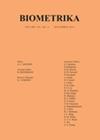利用高维生存数据优化治疗方案的无模型变量筛选法
IF 2.8
2区 数学
Q2 BIOLOGY
引用次数: 0
摘要
摘要 我们提出了一种针对高维生存数据的最佳治疗机制的无模型变量筛选方法。所提出的筛选方法提供了一个统一的框架,用于在预先指定的目标人群(包括作为特例的治疗组)中选择活性变量。基于这一框架,最佳治疗机制正是能使加权误分类错误率最小化的最佳分类器,其权重与生存结果变量、删减分布和预先指定的目标人群相关。我们的主要贡献在于将加权分类问题重新表述为假设人群中的分类问题,其中观察到的数据可被视为从结果依赖抽样中获得的样本,选择概率与权重成反比。因此,我们引入了加权 Kolmogorov-Smirnov 方法,用于在最佳治疗机制中选择活跃变量,从而扩展了用于二元分类的传统 Kolmogorov-Smirnov 方法。此外,所提出的筛选方法具有两层稳健性。第一层稳健性是由于所提出的方法不需要对治疗和协变量的生存结果进行任何模型假设,而另一层稳健性则是由于允许不指定治疗制度的形式,甚至不需要凸代损失,如 logit 损失或铰链损失。因此,所提出的筛选方法对模型的错误指定具有鲁棒性,而且可以将随机森林和提升等非参数学习方法应用于所选变量的进一步分析。本文建立了拟议方法的理论属性。通过模拟研究检验了所提方法的性能,并通过真实数据集进行了说明。本文章由计算机程序翻译,如有差异,请以英文原文为准。
A model-free variable screening method for optimal treatment regimes with high-dimensional survival data
Summary We propose a model-free variable screening method for the optimal treatment regime with high-dimensional survival data. The proposed screening method provides a unified framework to select the active variables in a prespecified target population, including the treated group as a special case. Based on this framework, the optimal treatment regime is exactly the optimal classifier that minimizes a weighted misclassification error rate, with weights associated with survival outcome variables, the censoring distribution, and a prespecified target population. Our main contribution involves reformulating the weighted classification problem into a classification problem within a hypothetical population, where the observed data can be viewed as a sample obtained from outcome-dependent sampling, with the selection probability inversely proportional to the weights. Consequently, we introduce the weighted Kolmogorov–Smirnov approach for selecting active variables in the optimal treatment regime, extending the conventional Kolmogorov–Smirnov method for binary classification. Additionally, the proposed screening method exhibits two levels of robustness. The first level of robustness is achieved because the proposed method does not require any model assumptions for survival outcome on treatment and covariates, whereas the other is attained as the form of treatment regimes is allowed to be unspecified even without requiring convex surrogate loss, such as logit loss or hinge loss. As a result, the proposed screening method is robust to model misspecifications, and nonparametric learning methods such as random forests and boosting can be applied to those selected variables for further analysis. The theoretical properties of the proposed method are established. The performance of the proposed method is examined through simulation studies and illustrated by a real dataset.
求助全文
通过发布文献求助,成功后即可免费获取论文全文。
去求助
来源期刊

Biometrika
生物-生物学
CiteScore
5.50
自引率
3.70%
发文量
56
审稿时长
6-12 weeks
期刊介绍:
Biometrika is primarily a journal of statistics in which emphasis is placed on papers containing original theoretical contributions of direct or potential value in applications. From time to time, papers in bordering fields are also published.
 求助内容:
求助内容: 应助结果提醒方式:
应助结果提醒方式:


